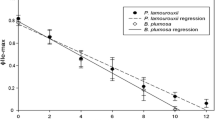Abstract
The adult, sacoglossan sea slug, Elysia clarki (Pierce et al. in Molluscan Res 26, 2006), sequesters functional chloroplasts in cells of the digestive diverticula from four species of macroalgae in the order Bryopsidales (Penicillus capitatus, Penicillus lamourouxii, Halimeda incrassata, and Halimeda monile). Feeding experiments were conducted in December, 2003, using individuals raised in the laboratory from egg masses laid by E. clarki adults which had been collected from Grassy Key, Florida, USA, and 29 species of macroalgae collected from the Florida Keys, Tampa Bay, Tarpon Springs, Florida, or Woods Hole, Massachusetts or obtained from the Culture Collection of Algae at the University of Texas at Austin, Texas. For the first 14-day post-metamorphosis, juveniles ate only the thin filamentous species, Bryopsis plumosa or Derbesia tenuissima. Transmission electron microscopy showed that the chloroplasts from both algae were sequestered intracellularly in juvenile slugs. Individuals offered any other macroalga, including the four species fed on by adults, did not feed on or incorporate any chloroplasts, and soon died. Juveniles switched from B. plumosa to P. capitatus at a length of ∼ 1.0 cm, and fixed for microscopy 14 days later had intact intracellular chloroplasts from both algae. Nucleotide sequences of the chloroplast gene, rbcL, from DNA extracted from E. clarki, collected from Vaca Key, Florida, were aligned with 22 other available macroalgal rbcL sequences indicating that these E. clarki adults had fed on three species of algae in the Bryopsidales including Bryopsis pennata, and TEM results partially confirmed this conclusion.







Similar content being viewed by others
References
Brandley B (1984) Aspects of the ecology and physiology of Elysia cf. furvacauda (Mollusca: Sacoglossa). Bull Mar Sci 34:207–219
Curtis NE, Massey SE, Schwartz JA, Tagihof H, Pierce SK (2004) The intracellular, functional chloroplasts in adult Elysia crispata come from several algal species, and are different from those in juvenile slugs. Integr Comp Biol 44:686
Curtis NE, Massey SE, Pierce SK (2006) The symbiotic chloroplasts in the sacoglossan Elysia clarki are from several algal species. Invertebr Biol (in press)
Doyle JJ, Doyle JL (1987) A rapid DNA isolation procedure for small quantities of fresh leaf tissue. Phytochem Bull 19:11–15
Felsenstein J (2004) PHYLIP (Phylogeny Inference Package) version 3.6. Distributed by the author. Department of Genome Sciences, University of Washington, Seattle
Jensen KR (1981) Observations on feeding methods in some Florida ascoglossans. J Moll Stud 47:190–199
Jensen KR (1983) Factors affecting feeding selectivity in herbivorous ascoglossa (Mollusca: Opistobranchia). J Exp Mar Biol Ecol 66:135–148
Jensen KR (1993) Morphological adaptations and plasticity of radular teeth of the Sacoglossa ( = Ascoglossa) (Mollusca: Opisthobranchia) in relation to their food plants. Biol J Linn Soc 48:135–155
Mondy WL, Pierce SK (2003) Apoptotic-like morphology is associated with annual synchronized death in kleptoplastic sea slugs (Elysia crispata). Invertebr Biol 122:126–137
Pierce SK, Biron RW, Rumpho ME (1996) Endosymbiotic chloroplasts in molluscan cells contain proteins synthesized after plastid capture. J Exp Biol 199:2323–2330
Pierce SK, Massey SE, Hanten JJ, Curtis NE (2003) Horizontal transfer of functional nuclear genes between multicellular organisms. Biol Bull 204:237–240
Pierce SK, Curtis NE, Massey SE, Bass AL, Karl SA, Finney CM (2006) A morphological and molecular comparison between Elysia crispata and a new species of kleptoplastic sacoglossan sea slug (Gastropoda: Opisthobranchia) from the Florida Keys, USA Molluscan Res 26:23–38
Pombert JF, Otis C, Lemieux C, Turmel M (2005) The chloroplast genome sequence of the green alga Pseudendoclonium akinetum (Ulvophyceae) reveals unusual structural features and new insights into the branching order of chlorophyte lineages. Mol Biol Evol 22:1903–1918
Thompson JD, Higgins DG, Gibson TJ (1994) ClustalW: improving the sensitivity of progressive multiple sequence alignment through sequence weighting, position-specific gap penalties and weight matrix choice. Nucleic Acids Res 22:4673–4680
Thorne JL, Kishino H, Felsenstein J (1992) Inching toward reality: an improved likelihood model of sequence evolution. J Mol Evol 34:3–16
Trench RK, Boyle JE, Smith DC (1973) The association between chloroplasts of Codium fragile and the mollusc Elysia viridis II. Chloroplast ultrastructure and photosynthetic carbon fixation in E. viridis Proc R Soc Lond B 184:63–81
Trowbridge CD (2000) The missing links: larval and post-larval development of the ascoglossan opistobranch Elysia viridis. J Mar Biol Assoc UK 80:1087–1094
Trowbridge CD, Todd CD (2001) Host–plant change in marine specialist herbivores: ascoglossan sea slugs on introduced macroalgae. Ecol Monogr 71:219–243
West HH, Harrigan JF, Pierce SK (1984) Hybridization of two populations of a marine opistobranch with different developmental patterns. Veliger 26:199–206
Acknowledgments
Specimens were collected under permits issued to SKP by the State of Florida. This work was supported by NSF grant #IBN 0315227. We thank Betty Loraamm for help with electron microscopy and Kathleen Hotchkiss for assistance with the figures. All experiments were conducted in compliance with the current laws of the United States of America.
Author information
Authors and Affiliations
Corresponding author
Additional information
Communicated by J.P. Grassle, New Brunswick
Rights and permissions
About this article
Cite this article
Curtis, N.E., Pierce, S.K., Massey, S.E. et al. Newly metamorphosed Elysia clarki juveniles feed on and sequester chloroplasts from algal species different from those utilized by adult slugs. Mar Biol 150, 797–806 (2007). https://doi.org/10.1007/s00227-006-0398-x
Received:
Accepted:
Published:
Issue Date:
DOI: https://doi.org/10.1007/s00227-006-0398-x




